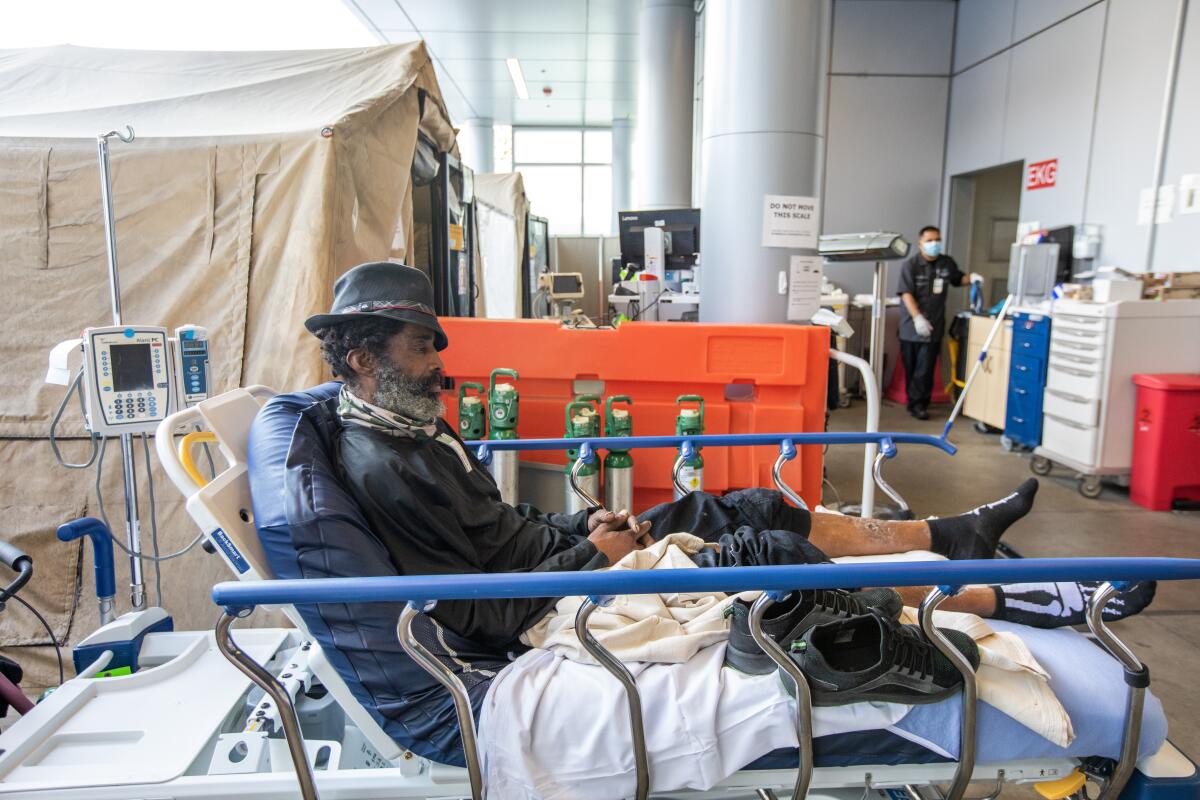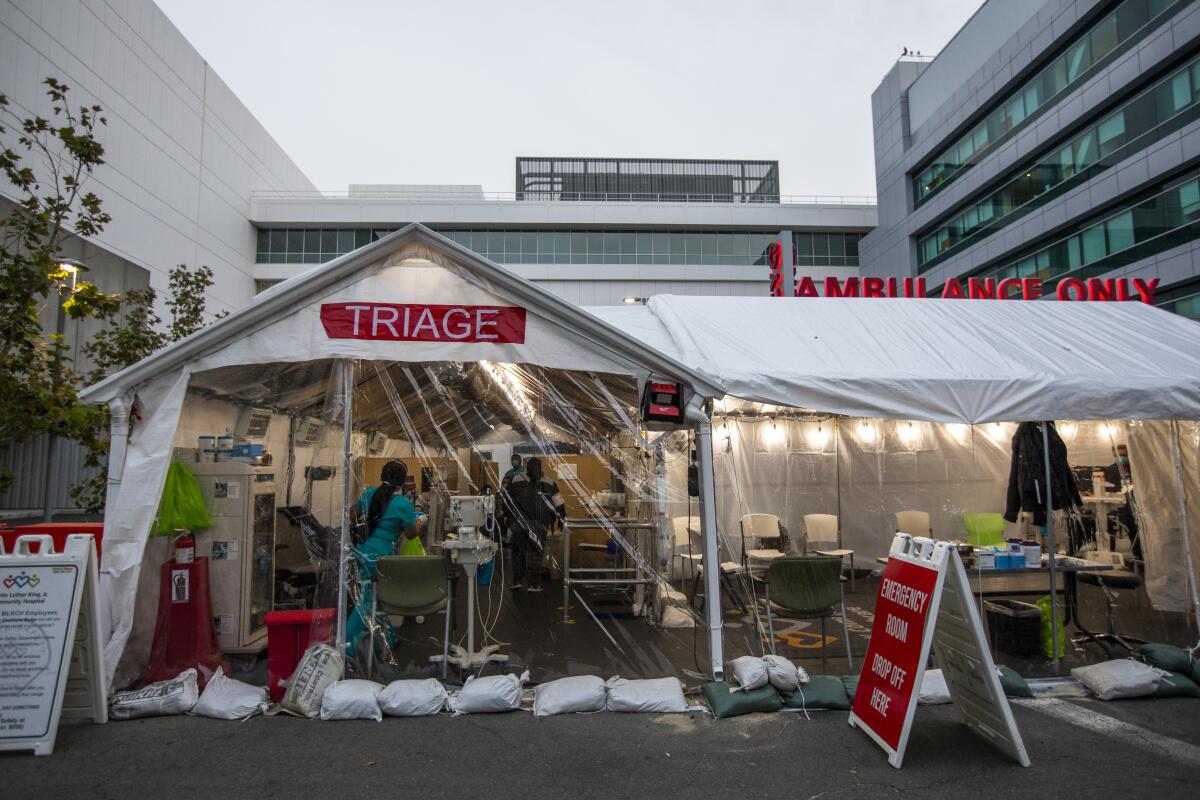MLK Community Hospital, a crucial safety-net facility serving the South Los Angeles area, may run out of money to pay its bills as soon as next year, hospital leaders are warning.
The nonprofit hospital, which was established to replace the closed King/Drew Medical Center, lost more than $42 million in the budget year that ended in June, according to officials at the privately run facility.
The Willowbrook facility was established with a unique funding system that included supplemental payments from the state and county government to keep the hospital afloat. But the funding formula has failed to keep pace with inflation and a steep increase in staffing expenses, among other shortcomings, MLK leaders said. The end of federal aid that had been given to hospitals during the COVID-19 pandemic was another blow, they added.
One of MLK’s biggest challenges is the fact that its emergency department has been deluged with four times as many patients as initially expected. That’s a problem because Medi-Cal, the California Medicaid program, does not fully cover the costs for providing emergency services, hospital leaders said.
All in all, the hospital said less than half of the revenue in its current $375-million budget comes from billing Medi-Cal and other payers, such as commercial health insurance plans, for its services.
“We really couldn’t operate the hospital based on what we’re able to bill payers for,” said Dr. Elaine Batchlor, chief executive of MLK Community Healthcare, which runs the hospital.
That gap was supposed to be closed in part with supplemental funding from Medi-Cal thanks to a state law enacted more than a decade ago to ensure the hospital would be financially sustainable.
That hasn’t worked out as planned. Hospital officials say the size of that supplement is set ahead of time based on costs incurred in the previous year — and does not increase if its actual costs prove to be higher. MLK also receives a county supplement, but that is not adjusted for inflation, they said.
California runs a program to help fund hospitals that serve poor patients, but MLK is unable to tap into it. Hospital officials said its Medi-Cal supplement was set up as an alternative to the state program to ensure MLK didn’t pull funds away from other safety-net medical facilities.
MLK Community Hospital in Willowbrook opened eight years ago to replace King/Drew Medical Center.
(Myung J. Chun / Los Angeles Times)
King/Drew Medical Center, which MLK replaced, lost its national accreditation in 2005 after repeated lapses in patient care. Federal regulators faulted King/Drew for giving patients the wrong drugs or dosages and using stun guns to subdue psychiatric patients. A Times investigation found that staff errors and neglect led to patient injuries and deaths.
Eight-year-old MLK Community Hospital, in turn, has touted its record for safety and quality: It boasts a five-star quality rating from federal regulators, has an “A” grade from a nonprofit focused on patient safety, and has been lauded for its maternity care.
“We have fulfilled our commitment to the community to provide high-quality, safe care,” Batchlor said. “But the funding model that was created … is not working anymore.”
When that model was drawn up, MLK was expected to handle 25,000 emergency department visits a year, hospital officials said. Last year, it tallied more than 100,000 such visits, ranking it among the busiest in the country. With only 29 rooms, the emergency department has been forced to carve out unconventional treatment spaces in chairs and on gurneys.

Rod Berryman waits in the ambulance bay outside the emergency department at MLK Community Hospital last year.
(Francine Orr / Los Angeles Times)
The surging numbers of patients at MLK have added to hospital expenses because mandated nurse-to-patient ratios required it to hire hundreds more nurses, Batchlor said. In the last fiscal year, MLK was more than $20 million over budget for temporary labor, she said, “and most of that is traveler nurses.”
The new hospital is about one-third the size of the medical center it replaced. The downsizing drew some criticism when MLK opened eight years ago, but experts at the time said the reduced capacity reflected the idea that the hospital should not become the community’s default provider of day-to-day care.
The shortage of other options has undermined that plan. Roughly 40% of its emergency department visits could have been handled in an outpatient clinic, MLK officials estimate, but patients have not been able to easily access that care in South L.A.
Financial margins for California hospitals remain lower than they were before the pandemic, and the data “paint a picture of a tremendously challenging future,” according to a study published this year in Health Affairs Scholar. Economic pressures have already forced the closure of Madera Community Hospital in rural Central California and spurred Beverly Hospital in Montebello to file for bankruptcy protection this spring.
The ongoing strain “will likely lead hospitals to raise prices to their commercially insured patients,” the study concluded. But MLK has few of those patients.
One of the reasons the hospital has struggled is that the bulk of its patients rely on public programs like Medi-Cal , which pay less than private insurance.
MLK’s heavy reliance on government reimbursement means “they have very little wiggle room,” said Glenn Melnick, a health economist at USC. “They are in a tough situation. It’s not like they can raise their prices to offset rising costs.”
On top of that, MLK officials said many Medi-Cal patients stay longer in the hospital than needed because it is hard to get timely transfers to other facilities. That drives up costs for MLK for caring for those patients, but not the corresponding payments from health plans, Batchlor said.
And the hospital has to bolster pay for private physicians who won’t work for Medi-Cal rates, spending millions of dollars each year to bring them up to market rates, Batchlor said.
Christopher M. Whaley, a health policy expert at the Brown University School of Public Health, said California hospitals can be divided into “the haves and the have-nots,” with community hospitals falling squarely in the second category.
Large health systems have been acquiring physician practices and funneling commercially insured patients into their hospitals, Whaley said. It “does a lot to further inequities and disparities,” he said, because it deprives community hospitals of those higher-reimbursement patients.

MLK Community Hospital set up a triage tent outside its emergency department last year to accommodate an influx of patients.
(Francine Orr / Los Angeles Times)
The Willowbrook hospital snagged a temporary reprieve with a $14-million state loan for hospitals in financial distress. Batchlor said it would help MLK make it through the coming winter but not fix its deeper problems.
Hospital leaders are pushing for L.A. County to increase its payments to the hospital to account for inflation. They also want the state to rework its financial supplements and increase funding for visits to the emergency department.
If nothing changes, Batchlor said, MLK will be forced to slash services and eventually close its doors. She was dubious that MLK could go the route of Beverly Hospital, which was acquired by Adventist Health this fall after the Montebello facility sought bankruptcy protection.
MLK “isn’t a hospital that’s going to generate significant profit for a health system,” Batchlor said.
County Supervisor Holly Mitchell, who represents Willowbrook, said MLK’s funding system must be revisited to better support a hospital that has “stepped up to the plate” to serve its community.
MLK “must not only survive but continue to thrive,” she said. “And we have to figure out how to make that happen.”
This story originally appeared on LA Times

